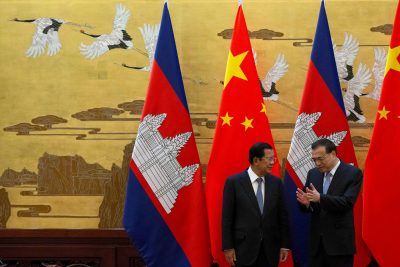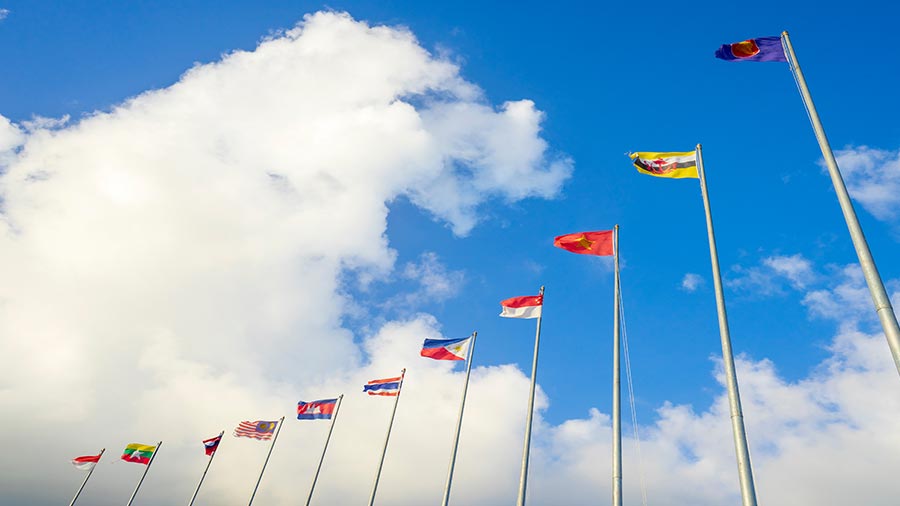China
No simple solution to China’s dominance in Cambodia

Author: Heimkhemra Suy, Phnom Penh
The origin of Cambodia–China ties can be traced back to the 13th century when a Chinese diplomat visited Angkor Wat, yet it is only in the last decade that the relationship has strengthened dramatically.
This China–Cambodia marriage of convenience presents both opportunities and challenges for Cambodia.
The country attracted US$3.6 billion in foreign direct investment in 2019, of which 43 per cent came from China. That year, bilateral trade between the two countries reached US$9 billion. China has financed around 70 per cent of Cambodia’s much-needed roads and bridges — by 2017, Cambodia had received US$4.2 billion in Chinese grants and loans. China also promised to deliver 4 billion RMB (US$588 million) in aid between 2019–2021. And Chinese investors support Cambodia’s garment industry, which represents 15 per cent of its 2019 GDP through export earnings, and generates 750,000 jobs. Also, as part of its coronavirus diplomacy, China has supported Cambodia by sending medical supplies to Cambodia, with Chinese President Xi Jinping describing Sino-Khmer relations ‘unbreakable’.
Cambodia’s options for foreign engagement are constrained by its weak soft and hard power, as well as the CPP’s pressing need for international political support. Cambodia seeks political support from China, partly to counterbalance Thailand and Vietnam. Support from China is increasingly important for the ruling Cambodian People’s Party (CPP) in light of growing criticism of the Party from the West.
Reliance on China alone is presenting diplomatic challenges. In 2009 for instance, at China’s request, Cambodia deported 20 Uyghur asylum seekers to China despite international outcry. In 2012, Cambodia blocked ASEAN from issuing a joint communique on China’s aggression in the South China Sea. These moves have pressured Cambodia’s relationship with fellow ASEAN member states and damaged its diplomatic credibility. Recently an ex-diplomat from Singapore even called for ASEAN to revoke Cambodian membership.
Overdependence on China could drive Cambodia into Beijing’s sphere of influence, changing the dynamic of Cambodia’s national security. The Wall Street Journal reported an alleged secret deal allowing China to station forces at Cambodia’s Ream Naval Base, potentially placing Cambodia in an uncomfortable position vis-a-vis its neighbours, especially Vietnam.
Meanwhile, overreliance on Chinese credit means Cambodia is exposed to concentration risks as well as the risk of getting caught in a debt trap. By 2018, Cambodia’s external public debt had reached US$7 billion, half owed to China. The debt could allow Beijing to pressure Cambodia into leasing out strategic facilities, such as the deep-water port at Sihanoukville. The location is a precious ‘pearl’ among China’s ‘string of pearls’, situated in the centre of mainland Southeast Asia. It provides a base for China to project maritime power into the Gulf of Thailand and the Straits of Malacca in a counterbalance to the United States and others.
Cambodia does supply China with food, crude oil and other mineral resources. And while Chinese firms in Cambodia generate some jobs, limited interaction with domestic companies means there are few opportunities for skill development among Cambodian workers. This makes China-dominated industries in Cambodia such as garment manufacturing fragile and unsustainable. Considerable Chinese investments have gone into casinos and real estate, where the benefits are largely exclusive to some privileged sections of Cambodian society.
Chinese aid and investment in Cambodia unfortunately lacks transparency and accountability, which can contribute to widespread corruption, malpractice and environmental degradation. China’s Union Development Group reportedly cleared 36,000 hectares of forest in Cambodia’s largest national park, Botum Sakor, for development. And half of the 4.6 million hectares of Cambodia’s land concessions were granted to Chinese firms.
Chinese investment should be welcome. Economic support from China is fast, stable and plentiful, allowing Cambodia to rapidly embark on much-needed structural reforms to reduce energy costs and enhance infrastructure. High electricity costs diminish Cambodia’s competitiveness and imposes a heavy financial burden on low-income families — only 19 per cent of households in rural areas have electricity access. Now supplying 47 per cent of Cambodia’s domestic energy, China-financed hydropower plants not only help tackle…
Business
Gordonstoun Severs Connections with Business Led by Individual Accused of Espionage for China

Gordonstoun school severed ties with Hampton Group over espionage allegations against chairman Yang Tengbo. He denies involvement and claims to be a victim of political tensions between the UK and China.
Allegations Lead to School’s Decision
Gordonstoun School in Moray has cut ties with Hampton Group International after serious allegations surfaced regarding its chairman, Yang Tengbo, who is accused of being a spy for the Chinese government. Known by the alias "H6," Mr. Tengbo was involved in a deal that aimed to establish five new schools in China affiliated with Gordonstoun. However, the recent allegations compelled the school to terminate their agreement.
Public Denial and Legal Action
In response to the spying claims, Mr. Tengbo publicly revealed his identity, asserting that he has committed no wrongdoing. A close associate of Prince Andrew and a former Gordonstoun student himself, Mr. Tengbo has strenuously denied the accusations, stating that he is a target of the escalating tensions between the UK and China. He has claimed that his mistreatment is politically motivated.
Immigration Challenges and Legal Responses
Yang Tengbo, also known as Chris Yang, has faced additional challenges regarding his immigration status in the UK. After losing an appeal against a ban enacted last year, he reiterated his innocence, condemning media speculation while emphasizing his commitment to clear his name. Gordonstoun, on its part, stated its inability to divulge further details due to legal constraints.
Source : Gordonstoun cuts ties with business chaired by man accused of spying for China
Business
China Dismantles Prominent Uyghur Business Landmark in Xinjiang – Shia Waves

The Chinese government demolished the Rebiya Kadeer Trade Center in Xinjiang, affecting Uyghur culture and commerce, prompting criticism from activists amid concerns over cultural erasure and human rights violations.
Demolition of a Cultural Landmark
The Chinese government recently demolished the Rebiya Kadeer Trade Center in Urumqi, Xinjiang, a vital hub for Uyghur culture and commerce, as reported by VOA. This center, once inhabited by more than 800 predominantly Uyghur-owned businesses, has been deserted since 2009. Authorities forcibly ordered local business owners to vacate the premises before proceeding with the demolition, which took place without any public notice.
Condemnation from Activists
Uyghur rights activists have condemned this demolition, perceiving it as part of China’s broader strategy to undermine Uyghur identity and heritage. The event has sparked heightened international concern regarding China’s policies in Xinjiang, which have been characterized by allegations of mass detentions and cultural suppression, prompting claims of crimes against humanity.
Rebiya Kadeer’s Response
Rebiya Kadeer, the center’s namesake and a notable Uyghur rights advocate, criticized the demolition as a deliberate attempt to erase her legacy. Kadeer, who has been living in exile in the U.S. since her release from imprisonment in 2005, continues to advocate for Uyghur rights. She has expressed that her family members have suffered persecution due to her activism, while the Chinese government has yet to comment on the legal ramifications of the demolition.
Source : China Demolishes Uyghur Business Landmark in Xinjiang – Shia Waves
China
China Expands Nationwide Private Pension Scheme After Two-Year Pilot Program

China’s private pension scheme, previously piloted in 36 cities, will roll out nationwide on December 15, 2024, enabling workers to open tax-deferred accounts. The initiative aims to enhance retirement savings, address aging population challenges, and stimulate financial sector growth.
After a two-year pilot program, China has officially expanded its private pension scheme nationwide. Starting December 15, 2024, workers covered by urban employee basic pension insurance or urban-rural resident basic pension insurance across the country can participate in this supplementary pension scheme. This nationwide rollout represents a significant milestone in China’s efforts to build a comprehensive pension system, addressing the challenges of a rapidly aging population.
On December 12, 2024, the Ministry of Human Resources and Social Security, together with four other departments including the Ministry of Finance, the State Taxation Administration, the Financial Regulatory Administration, and the China Securities Regulatory Commission, announced the nationwide implementation of China’s private pension scheme effective December 15, 2024. The initiative extends eligibility to all workers enrolled in urban employee basic pension insurance or urban-rural resident basic pension insurance.
A notable development is the expansion of tax incentives for private pensions, previously limited to pilot cities, to a national scale. Participants can now enjoy these benefits across China, with government agencies collaborating to ensure seamless implementation and to encourage broad participation through these enhanced incentives.
China first introduced its private pension scheme in November 2022 as a pilot program covering 36 cities and regions, including major hubs like Beijing, Shanghai, Guangzhou, Xi’an, and Chengdu. Under the program, individuals were allowed to open tax-deferred private pension accounts, contributing up to RMB 12,000 (approximately $1,654) annually to invest in a range of retirement products such as bank deposits, mutual funds, commercial pension insurance, and wealth management products.
Read more about China’s private pension pilot program launched two years ago: China Officially Launches New Private Pension Scheme – Who Can Take Part?
The nationwide implementation underscores the Chinese government’s commitment to addressing demographic challenges and promoting economic resilience. By providing tax advantages and expanding access, the scheme aims to incentivize long-term savings and foster greater participation in personal retirement planning.
The reform is expected to catalyze growth in China’s financial and insurance sectors while offering individuals a reliable mechanism to enhance their retirement security.
| This article was first published by China Briefing , which is produced by Dezan Shira & Associates. The firm assists foreign investors throughout Asia from offices across the world, including in in China, Hong Kong, Vietnam, Singapore, and India . Readers may write to info@dezshira.com for more support. |
Read the rest of the original article.






